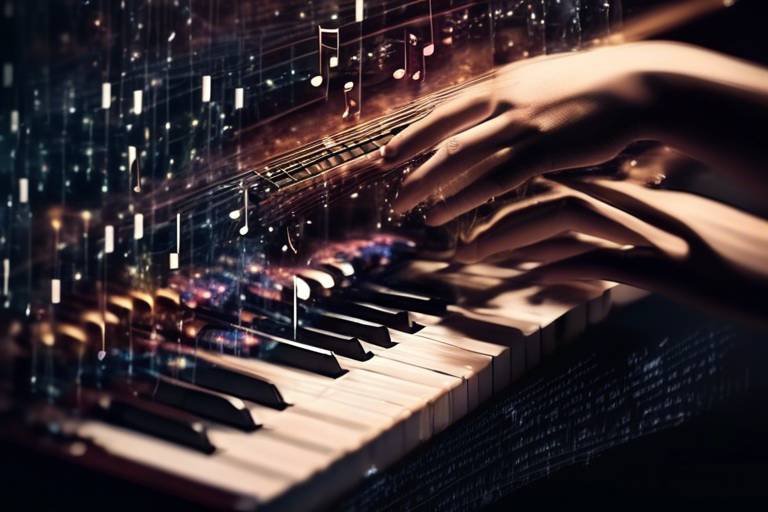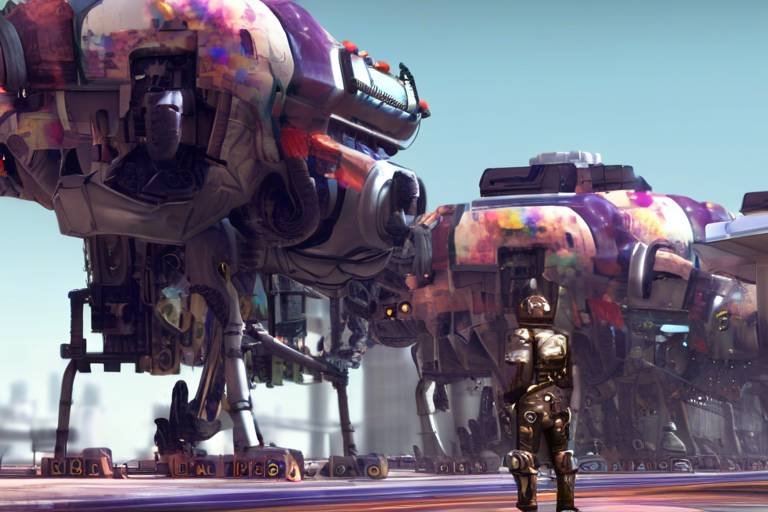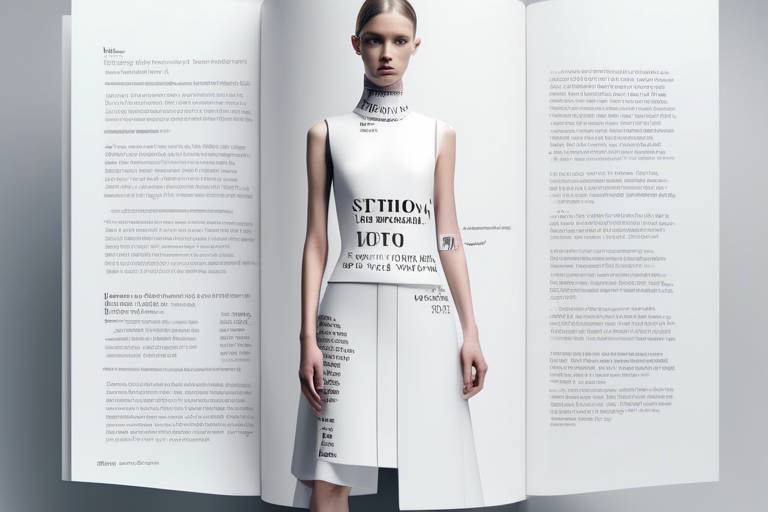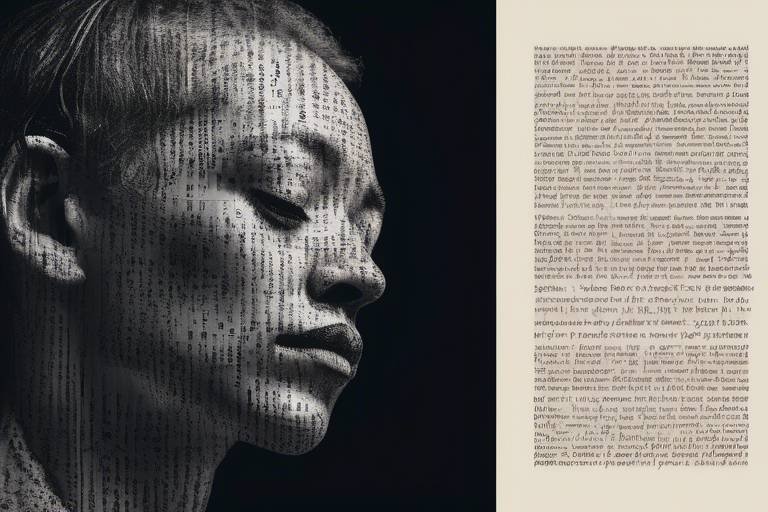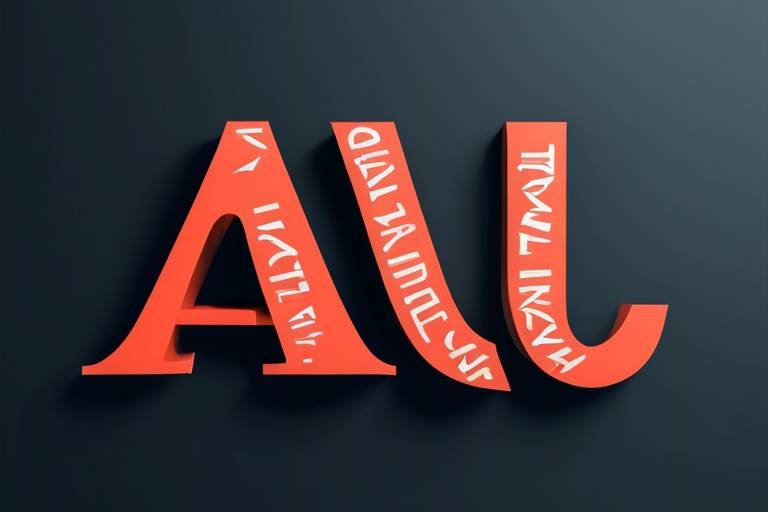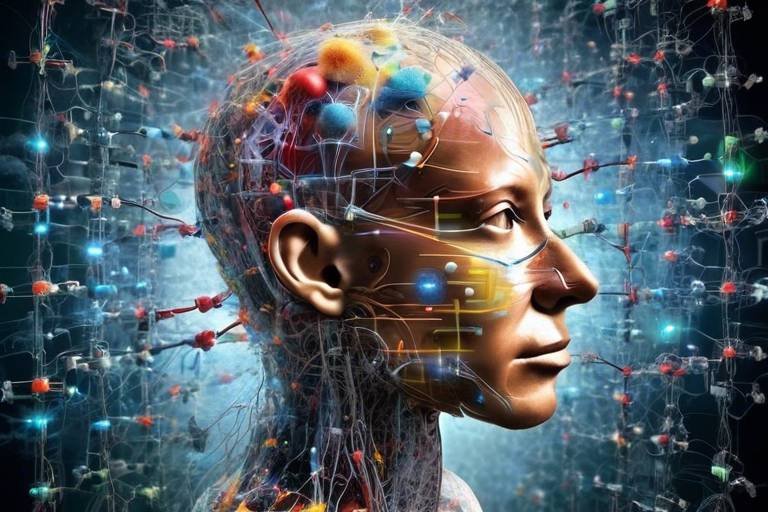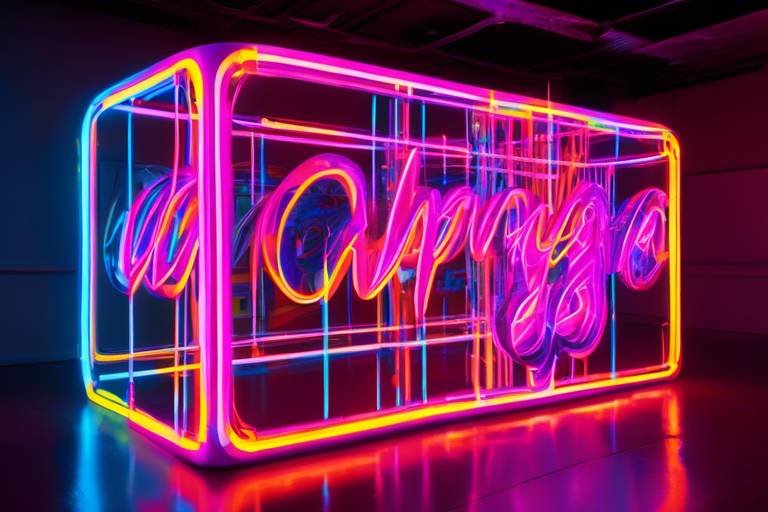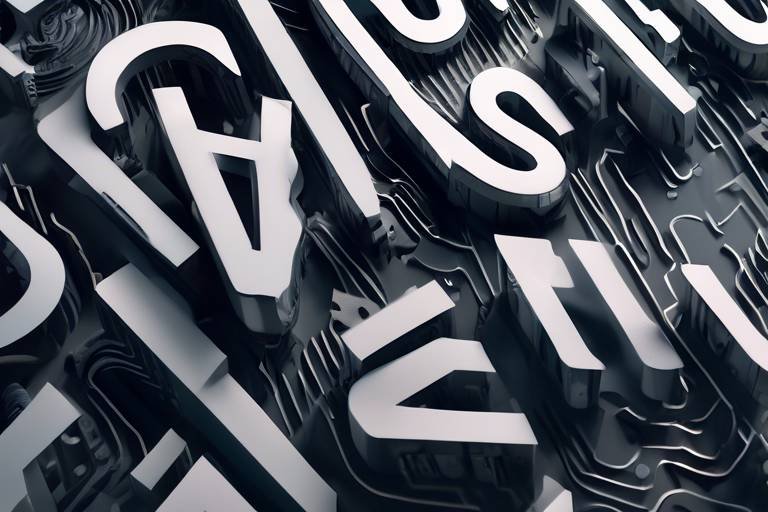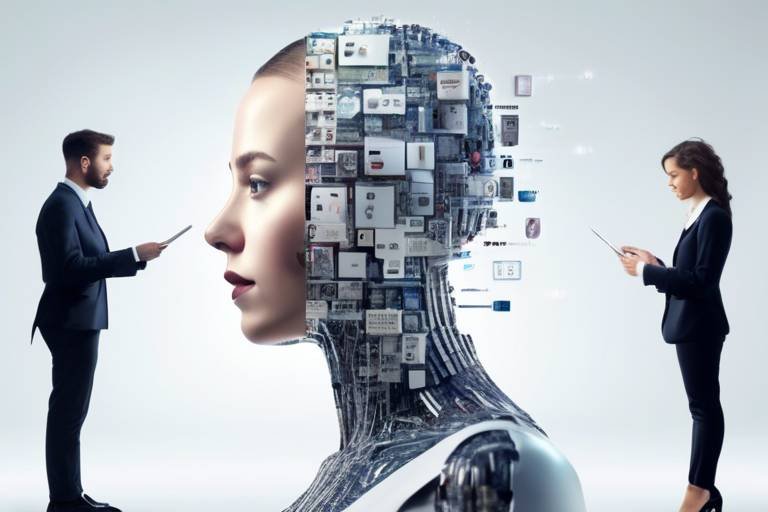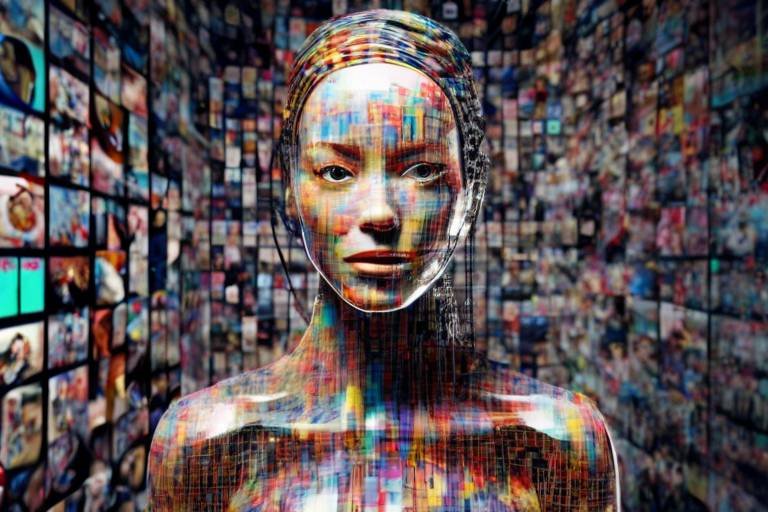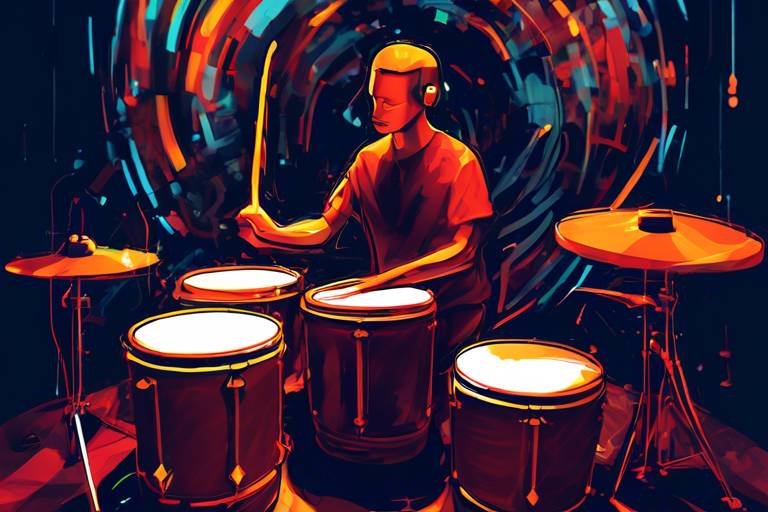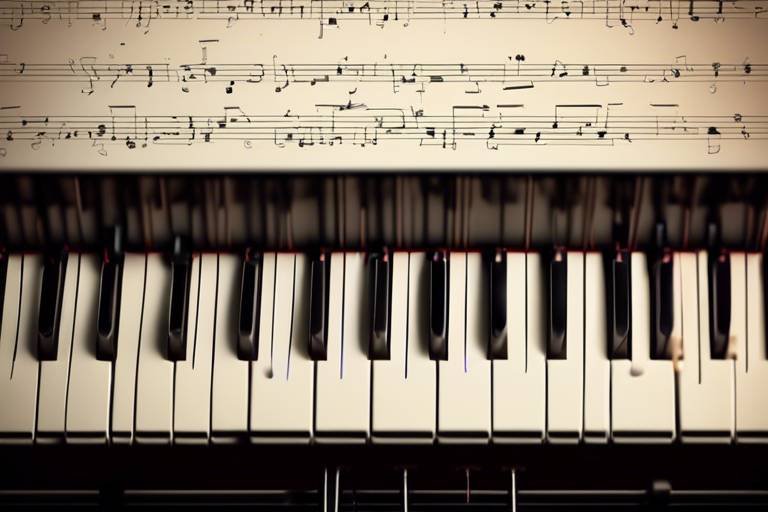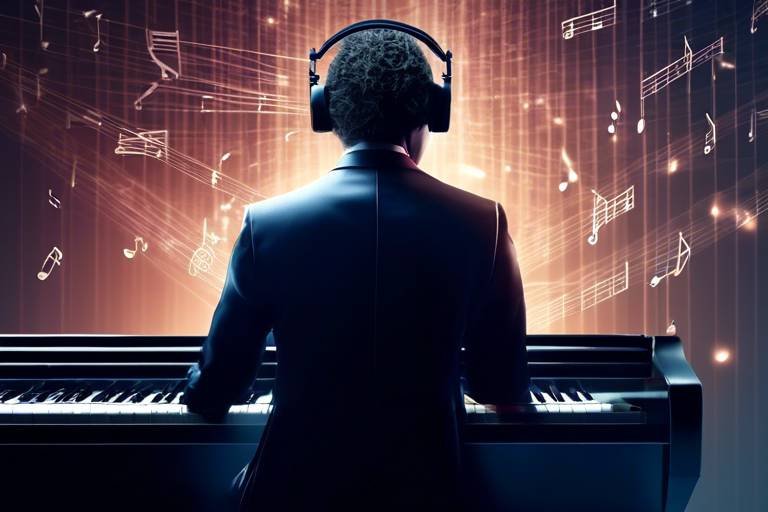Harmony of AI in Instrumental Music
In today's rapidly evolving digital landscape, the intersection of artificial intelligence and instrumental music has become a fascinating frontier. Imagine a world where melodies are not just crafted by human hands but also by algorithms that learn and evolve. This article explores how AI is reshaping the way we compose, perform, and appreciate music. With each passing day, the capabilities of AI are expanding, leading to innovative compositions and live performances that challenge our traditional understanding of music creation.
To appreciate the current state of AI in music, we must first understand its historical development. The journey began in the mid-20th century when pioneers started exploring the use of computers in music composition. Fast forward to today, and we see a rich tapestry of technological advancements that have paved the way for AI's involvement in music. From the first rudimentary algorithms that could generate simple tunes to sophisticated neural networks capable of composing symphonies, the evolution of AI in music has been nothing short of remarkable.
One of the most exciting aspects of AI in instrumental music is its ability to create original compositions. Using complex algorithms, AI can analyze vast amounts of musical data, learning patterns, styles, and structures that define different genres. The implications for composers are profound. While some may view AI as a competitor, others see it as a valuable tool that can enhance the creative process. Imagine collaborating with an AI that can suggest chord progressions or generate entire pieces based on a few input parameters. The partnership between human creativity and machine learning opens up a world of possibilities.
At the heart of AI music generation lies machine learning. Techniques such as neural networks and deep learning are the driving forces behind these innovative compositions. Neural networks mimic the way human brains work, allowing machines to learn from data and improve over time. By training on thousands of pieces of music, these systems can produce compositions that are not only unique but also emotionally resonant. This capability raises intriguing questions: Can a machine truly understand the emotional weight of a melody? Or is it simply mimicking patterns it has learned?
Several AI systems have gained recognition for their ability to produce compelling instrumental music. For instance, AIVA (Artificial Intelligence Virtual Artist) has made waves in the music industry by composing pieces that have been used in films and video games. Another notable mention is OpenAI's MuseNet, which can generate music in various styles, blending influences from classical to contemporary genres. These AI composers are not just novelties; they represent a significant shift in how we think about authorship and creativity in music.
AI is not only transforming composition but also the very nature of live performances. Imagine attending a concert where the music is being generated in real-time, responding to the audience's energy and engagement. This is becoming a reality as artists incorporate AI into their performances. Interactive systems can analyze audience reactions and adjust the music accordingly, creating a truly immersive experience. This dynamic interplay between human musicians and AI can lead to performances that are unique every time, much like a conversation where both parties contribute to the flow.
Technologies that enable real-time music generation are at the forefront of this transformation. These systems can analyze the mood of the audience, the tempo of the performance, and even the style of the musicians on stage to generate music that complements the live act. Picture a jazz band where an AI system improvises alongside the musicians, creating an ever-evolving soundscape that reflects the energy of the moment. This synergy not only enhances the performance but also captivates the audience in ways that static compositions cannot.
Collaboration between human musicians and AI is an exciting concept that is gaining traction. Artists are beginning to see AI not just as a tool but as a partner in creativity. This collaboration can lead to groundbreaking performances where AI-generated elements seamlessly blend with live instrumentation. Musicians can explore new creative territories, pushing the boundaries of what is musically possible. As we delve deeper into this partnership, the lines between human and machine creativity may blur, leading to a new era in music.
As we look to the future, the potential advancements in AI technology promise to further influence the creation and appreciation of instrumental music. Imagine AI systems that can understand cultural contexts, adapting their compositions to resonate with diverse audiences worldwide. The possibilities are endless, and as AI continues to evolve, so too will our relationship with music. It’s an exhilarating time to be both a musician and a listener, as we stand on the brink of a musical revolution.
- Can AI compose music that resonates emotionally with listeners? Yes, while AI can analyze and mimic emotional patterns, the interpretation of emotion remains subjective and deeply human.
- Will AI replace human musicians? Rather than replacing them, AI is more likely to serve as a tool that enhances human creativity and collaboration.
- How can I incorporate AI into my music practice? Many software tools and applications are available that allow musicians to experiment with AI-generated music, providing a platform for exploration and creativity.

The Evolution of AI in Music
The journey of artificial intelligence (AI) in the realm of music is nothing short of fascinating. It’s like watching a child grow into a talented musician, each phase marked by significant milestones that reflect both technological advancements and artistic exploration. The seeds of AI in music were sown long ago, with early experiments in algorithmic composition dating back to the 1950s. During this time, pioneers like Lejaren Hiller began to explore the potential of computers to create music, leading to the composition of pieces like the famous "Illiac Suite." This was just the beginning of a long and intricate relationship between technology and creativity.
As we moved into the 1980s and 1990s, the evolution of music technology began to accelerate. The introduction of MIDI (Musical Instrument Digital Interface) revolutionized how musicians interacted with computers, allowing for more complex compositions and performances. This era also saw the rise of software that could analyze and generate music, paving the way for the AI-driven solutions we see today. Fast forward to the 21st century, and we find ourselves at a remarkable crossroads where machine learning and deep learning are reshaping the landscape of instrumental music.
Today, AI systems are not just tools; they are becoming co-creators in the artistic process. With the advent of powerful algorithms capable of analyzing vast amounts of musical data, AI can now generate original compositions that are often indistinguishable from those created by human composers. This evolution raises intriguing questions about creativity and authorship. For instance, can a machine truly understand the emotional nuances of music, or is it merely mimicking patterns it has learned?
To illustrate the evolution of AI in music, consider the following table that highlights key milestones:
| Year | Milestone | Description |
|---|---|---|
| 1957 | First Algorithmic Composition | Lejaren Hiller creates the "Illiac Suite," one of the first pieces of music composed by a computer. |
| 1983 | Introduction of MIDI | MIDI allows electronic instruments and computers to communicate, changing the way music is produced. |
| 2000s | Rise of Machine Learning | Machine learning techniques begin to be applied to music generation, enhancing creative possibilities. |
| 2016 | AI Composers Gain Recognition | AI systems like AIVA and OpenAI's MuseNet start producing music that receives critical acclaim. |
With each passing year, the integration of AI into music becomes more sophisticated. Today, we see AI not only composing music but also assisting in the creative process, providing musicians with new tools to experiment and innovate. This evolution has sparked a wave of interest and debate within the music community about the implications of AI in art. Are we witnessing the dawn of a new era in music, where the line between human and machine creativity blurs? Only time will tell, but one thing is certain: the evolution of AI in music is just beginning.

AI-Generated Compositions
The rise of artificial intelligence in the realm of music has opened up a fascinating new frontier, particularly in the creation of original instrumental compositions. Imagine a world where machines can compose music that resonates with human emotions, evoking feelings just like a seasoned composer. This isn't just a dream; it's becoming a reality. AI algorithms are now capable of analyzing vast amounts of musical data, learning from it, and generating unique pieces that reflect various styles and genres. This process not only challenges our understanding of creativity but also redefines the role of composers and musicians in the creative process.
At the heart of AI-generated compositions lies a blend of advanced algorithms and extensive datasets. These algorithms can dissect the nuances of music—melody, harmony, rhythm—and use this understanding to create something entirely new. For instance, a composer might input a few notes or a specific style, and the AI can expand upon that, producing a full orchestral piece or a minimalist piano melody. The implications for musicians are profound. Traditional notions of authorship are being reexamined as we contemplate whether a piece created by an AI can be considered art in the same way as a human-composed work.
One of the most exciting aspects of AI in music composition is the variety of techniques used to generate these pieces. Machine learning, particularly through methods like neural networks and deep learning, empowers AI to learn from the intricacies of existing music. These techniques allow AI to not only replicate styles but also innovate within them. For instance, a neural network can be trained on classical compositions, jazz improvisations, or even contemporary pop songs, enabling it to create a new piece that might blend elements from all these genres.
To illustrate this point, let's look at some notable AI systems that have made waves in the music industry. For example, AIVA (Artificial Intelligence Virtual Artist) has gained recognition for its ability to compose emotional soundtracks that are often indistinguishable from those created by human composers. Another example is OpenAI's MuseNet, which can generate compositions across various styles and instruments, showcasing the vast potential of AI in music creation. These systems not only challenge the traditional roles of musicians but also invite collaboration, where human creativity meets machine efficiency.
As we delve deeper into the world of AI-generated compositions, it's essential to consider the implications for the future of music. Will AI become a standard tool in the composer’s toolkit, or will it replace the need for human creativity altogether? While some purists might argue that nothing can replace the human touch in music, others see AI as a partner that enhances the creative process, allowing musicians to explore new horizons. The conversation surrounding AI in music is just beginning, and it promises to be as dynamic and evolving as the music itself.

Machine Learning Techniques
When we talk about machine learning in music, it’s like opening a treasure chest filled with innovative tools that composers can use to craft new sounds and melodies. At the heart of this revolution are algorithms that learn from vast amounts of data, allowing them to generate music that can be surprisingly intricate and emotive. Imagine teaching a computer to understand the nuances of a Beethoven symphony or the rhythm of a jazz improvisation—this is precisely what machine learning techniques accomplish.
One of the most fascinating methods utilized in music generation is neural networks. These are systems inspired by the human brain, designed to recognize patterns and make decisions. In the context of music, neural networks can analyze thousands of compositions, learning the structure, harmony, and style of different genres. For instance, a neural network trained on classical music can produce a new piece that mimics the style of Mozart, complete with intricate melodies and harmonies. This technology doesn't just replicate existing music; it creates something new, blending influences in ways that are both innovative and captivating.
Another powerful approach is deep learning, a subset of machine learning that involves layers of algorithms working together to process data. Deep learning models can generate music that evolves over time, adapting to changes in rhythm and melody, making them ideal for creating soundtracks for films or video games. The ability to generate music that responds dynamically to visual stimuli or audience reactions opens up a world of possibilities for interactive performances.
To give you a clearer picture, consider the following table that outlines some key machine learning techniques used in music generation:
| Technique | Description | Application |
|---|---|---|
| Neural Networks | Models inspired by the human brain that recognize patterns in data. | Generating compositions in various styles. |
| Deep Learning | Involves multiple layers of algorithms to process complex data. | Creating adaptive soundtracks for media. |
| Reinforcement Learning | A method where algorithms learn through trial and error. | Improving performance in real-time collaborations. |
These techniques are not just theoretical; they are actively shaping the music landscape. As artists and producers experiment with these technologies, they uncover new creative possibilities that challenge traditional notions of composition. For example, some musicians are beginning to see AI as a collaborator rather than a replacement, using it to enhance their own creative processes. This partnership can lead to unexpected results, much like a painter blending colors on a canvas—each stroke influenced by the last, creating a masterpiece that neither could achieve alone.
In conclusion, machine learning techniques are revolutionizing the way music is created. They are not merely tools; they are partners in the creative process, opening doors to new forms of expression. As we continue to explore these technologies, the future of instrumental music looks not only exciting but also profoundly collaborative.

Notable AI Composers
In the realm of instrumental music, the rise of artificial intelligence has birthed a new generation of composers that are not only fascinating but also challenge our traditional views of creativity. One of the most notable AI composers is AIVA (Artificial Intelligence Virtual Artist), which has made waves by composing emotional soundtracks for films, advertisements, and even video games. AIVA utilizes deep learning algorithms to analyze thousands of classical music scores, learning the intricacies of melody, harmony, and rhythm. The result? Original compositions that resonate with human emotions, often indistinguishable from those created by human composers.
Another remarkable AI composer is OpenAI's MuseNet. This sophisticated neural network can generate music in various genres, from classical to contemporary pop. MuseNet is trained on a diverse dataset, allowing it to blend styles and create unique pieces that reflect a wide range of musical influences. Imagine a piece that starts with the elegance of Bach and seamlessly transitions into the energy of a modern rock anthem—this is the kind of magic MuseNet can create.
Additionally, there’s Google's Magenta, a project that explores the role of machine learning in the creative process. Magenta not only generates melodies but also collaborates with musicians to enhance their creative output. By offering suggestions and improvisations, Magenta acts as a creative partner, pushing the boundaries of what is possible in music composition. This collaborative approach is a game-changer, as it allows artists to experiment and explore new sonic landscapes that they might not have considered before.
These AI composers are not just tools; they are becoming integral parts of the music creation process. As we delve deeper into the capabilities of AI, we must also consider the implications of their work. For instance, questions arise about authorship and ownership. If an AI composes a piece of music, who owns the rights? Is it the programmer, the user, or the AI itself? These are profound questions that the music industry must address as AI continues to evolve.
Moreover, the presence of AI composers has sparked discussions about the future of human musicianship. Will musicians become obsolete, or will they adapt and evolve alongside these technologies? The answer may lie in collaboration. Just as jazz musicians often improvise together, human artists can work with AI to create something entirely new and exciting. This synergy could lead to a renaissance in music, where the lines between human and machine creativity blur, resulting in innovative sounds that captivate audiences.
In conclusion, notable AI composers like AIVA, MuseNet, and Magenta are reshaping the landscape of instrumental music. They challenge our perceptions of creativity and collaboration, opening up new avenues for exploration and expression. As we embrace this technological revolution, the future of music appears to be a harmonious blend of human emotion and artificial intelligence.
- What is AIVA? AIVA is an AI composer that creates original soundtracks for various media by analyzing classical music scores.
- How does MuseNet work? MuseNet uses deep learning to generate music across different genres, blending styles for unique compositions.
- What is Magenta? Magenta is a Google project that explores machine learning in music, offering collaboration tools for musicians.
- Will AI replace human musicians? It's unlikely; instead, AI is expected to enhance human creativity and lead to new forms of musical collaboration.

AI in Live Performances
Imagine stepping into a concert hall where the music is not only played but also created in real-time, responding to the energy of the audience. This is the magic that artificial intelligence brings to live performances. AI is revolutionizing how we experience music, transforming traditional concerts into interactive events that blur the lines between performer and audience. With AI systems capable of analyzing crowd reactions, musicians can adapt their performances on the fly, creating a unique atmosphere that feels both personal and exhilarating.
One of the most fascinating aspects of AI in live music is the emergence of real-time music generation. This technology allows AI to compose and perform music instantaneously, reacting to various inputs such as audience clapping, vocalizations, or even the tempo of the room. Imagine an AI that can sense the excitement in the crowd and ramp up the energy of the music accordingly! This not only enhances the audience's experience but also allows musicians to explore new creative avenues. The collaboration between human artists and AI can lead to unexpected and thrilling outcomes, making each performance a one-of-a-kind experience.
Moreover, the concept of collaborative AI musicians is gaining traction. These AI systems are not merely tools; they are partners in the creative process. Musicians can work alongside AI to enhance their performances, experimenting with new sounds and styles that they might not have considered before. For instance, a jazz musician could improvise with an AI that understands their playing style, generating complementary melodies and rhythms in real-time. This synergy can lead to a fusion of human emotion and machine precision, resulting in performances that are both innovative and deeply engaging.
As we look to the future, the possibilities are endless. AI could enable musicians to reach audiences across the globe simultaneously, creating virtual concerts where people can interact with AI-generated music from the comfort of their homes. Furthermore, advancements in AI technology may lead to even more sophisticated systems capable of understanding complex musical structures and emotional cues, allowing for deeper engagement between performers and their audience.
In conclusion, the integration of AI in live performances is not just a passing trend; it represents a significant shift in how music is created and experienced. As technology continues to advance, we can expect to see even more innovative applications of AI that will redefine the concert experience and challenge our perceptions of what music can be. The harmony of AI and live performance is just beginning, and the future looks incredibly promising.
- How does AI generate music in real-time during live performances?
AI uses algorithms that analyze various inputs, such as audience reactions and the performance environment, to create music that evolves in response to these factors. - Can AI replace human musicians in live performances?
While AI can enhance live performances, it is unlikely to replace human musicians. Instead, it serves as a collaborator, adding new dimensions to the creative process. - What are some examples of AI systems used in live music?
Notable examples include AIVA, an AI composer, and IBM's Watson Beat, which can analyze and generate music based on emotional cues. - How can musicians benefit from collaborating with AI?
Musicians can explore new sounds and styles, receive real-time feedback, and create unique performances that enhance audience engagement.

Real-Time Music Generation
Imagine stepping into a concert where the music isn't just played; it’s created right before your eyes! is revolutionizing the way we experience live performances, making them more interactive and engaging than ever before. This innovative technology allows AI systems to compose and perform music on the fly, responding to the mood of the audience and the nuances of the performance. It’s like having a musical conversation where the AI listens, learns, and adapts, creating a unique experience for every show.
At the heart of real-time music generation are advanced algorithms that analyze various inputs—from the musicians’ playing styles to the audience's reactions. These algorithms can generate melodies, harmonies, and rhythms that complement the live performance, turning a traditional concert into a dynamic and immersive event. For instance, if a guitarist plays a particular riff, the AI can instantly create a backing track that matches the style and tempo, enhancing the overall sound. This not only enriches the performance but also adds an element of surprise that keeps the audience on their toes.
What makes this technology even more fascinating is its ability to learn from past performances. By utilizing machine learning techniques, AI systems can analyze data from previous shows to improve their real-time compositions. This means that the more a system performs, the better it becomes at understanding what works and what doesn’t, leading to increasingly sophisticated musical outputs. It’s akin to how a chef perfects a recipe through trial and error, adjusting flavors based on feedback. The result? A musical experience that feels fresh and innovative every time.
Moreover, real-time music generation isn't limited to just one genre. It can adapt to various styles, whether it's jazz, classical, electronic, or rock. This versatility opens up exciting possibilities for collaboration between human musicians and AI. Imagine a jazz ensemble where the AI takes cues from the saxophonist’s improvisation, weaving in spontaneous melodies that elevate the performance to new heights. The synergy between human creativity and AI's computational power creates a rich tapestry of sound that captivates audiences.
As we look to the future, the potential for real-time music generation is limitless. With advancements in technology, we can expect even more sophisticated AI systems that not only generate music but also understand the emotional context of a performance. This could lead to AI that can feel the energy of the crowd and adjust the music accordingly, creating an experience that is not just heard but felt deeply by everyone present. The line between performer and audience blurs, as everyone becomes part of a shared musical journey.
In conclusion, real-time music generation is not just a trend; it’s a glimpse into the future of live music. As artists continue to explore this technology, we can anticipate a new wave of performances that are interactive, responsive, and utterly unforgettable. The harmony of human creativity and artificial intelligence is set to redefine the concert experience, making it more vibrant and engaging than ever before.
- What is real-time music generation?
Real-time music generation refers to the ability of AI systems to compose and perform music instantaneously during live performances, adapting to the musicians and audience in real-time.
- How does AI learn to generate music in real-time?
AI uses machine learning techniques to analyze data from previous performances, allowing it to improve its compositions based on feedback and audience reactions.
- Can AI generate music in different genres?
Yes! AI can adapt to various musical styles, making it versatile enough to collaborate with musicians across genres like jazz, classical, rock, and more.
- What are the benefits of using AI in live performances?
AI enhances live performances by providing dynamic, responsive music that complements human musicians, creating a unique and engaging experience for the audience.

Collaborative AI Musicians
Imagine stepping onto a stage, the lights dimming as the crowd buzzes with anticipation. But instead of a traditional band, you’re greeted by a fusion of human talent and artificial intelligence—a collaborative AI musician that brings a new dimension to live performances. This innovative approach is reshaping the landscape of music, allowing artists to explore uncharted territories of creativity. So, how does this collaboration work, and what does it mean for the future of music?
At its core, collaborative AI musicians are designed to enhance, rather than replace, human creativity. These systems analyze the style, tempo, and even the emotional undertones of a musician's performance, responding in real-time to create a dynamic musical experience. For instance, a guitarist might play a riff, and the AI could instantly generate a complementary melody or rhythm, effectively becoming a bandmate that never tires and is always ready to jam.
One of the most exciting aspects of these collaborations is the creative synergy that emerges. Artists can experiment with sounds and styles they might not typically explore on their own. This synergy allows for the blending of genres and the creation of unique pieces that reflect both human emotion and AI precision. Take, for example, the project OpenAI's MuseNet, which can generate music in various styles, from classical to pop, based on the input it receives from human musicians. This kind of interaction opens up a world of possibilities, where the boundaries of traditional music are pushed further than ever before.
Additionally, the use of AI in live performances can lead to more interactive experiences for audiences. Imagine a concert where the music evolves based on the energy and reactions of the crowd. AI systems can analyze audience responses—like clapping, cheering, or even silence—and adjust the performance accordingly. This creates a feedback loop that not only enhances the experience for the audience but also allows musicians to engage in a deeper level of expression.
However, the rise of collaborative AI musicians also raises important questions about the future of creativity and authorship in music. Who owns the rights to a piece created collaboratively between a human and an AI? Is the AI merely a tool, or does it deserve recognition as a co-creator? These are vital discussions that need to take place as we embrace this new musical landscape.
In conclusion, the collaboration between human musicians and AI is not just a passing trend; it’s a profound shift in how music is created and experienced. As technology continues to evolve, the potential for these partnerships to redefine the music industry is immense. Together, human creativity and artificial intelligence can unlock new dimensions of sound, leading to a future where every performance is a unique, collaborative masterpiece.
- What is a collaborative AI musician?
A collaborative AI musician is an artificial intelligence system designed to work alongside human musicians, enhancing their creativity and performance by generating music in real-time. - How does AI analyze a musician's performance?
AI systems utilize algorithms to analyze various aspects of a performance, including tempo, style, and emotional cues, allowing them to respond dynamically to the musician's input. - Can AI create music without human input?
Yes, AI can generate music independently, but the most exciting results often come from collaborations with human musicians, where both contribute to the creative process. - What are the implications of AI in music?
The use of AI in music raises questions about authorship, creativity, and the future of the music industry, as it challenges traditional notions of how music is created and who gets credit for it.

The Future of AI in Instrumental Music
As we look ahead, the future of AI in instrumental music is not just a mere continuation of current trends; it’s an exciting frontier brimming with possibilities that could redefine how we create, perform, and experience music. Imagine a world where every note played is not just a product of human creativity but a harmonious blend of human emotion and artificial intelligence. This fusion could lead to unprecedented innovations in musical expression, making the art form more accessible and diverse than ever.
One of the most thrilling prospects is the enhancement of personalized music experiences. With AI algorithms capable of analyzing individual preferences, we could see the emergence of music that adapts in real-time to the listener's mood or environment. For instance, picture a scenario where an AI composer crafts a unique instrumental piece tailored to your emotions as you listen. This could transform mundane moments into extraordinary musical journeys, making every listening session feel like a personalized concert.
Moreover, advancements in machine learning will likely lead to even more sophisticated AI composers. These systems will not only generate music but will also learn from feedback, evolving their compositions over time. This raises intriguing questions: Will we start to see AI composers credited alongside human musicians? Will they become part of the music industry’s fabric, influencing genres and styles in ways we can’t yet imagine? The potential for collaboration between human artists and AI could lead to a new wave of creativity, where the boundaries of genres are blurred, and new styles emerge.
Additionally, the integration of AI in live performances is set to revolutionize the concert experience. Imagine attending a concert where the music is not just played but created live, tailored to the audience's reactions. AI systems capable of analyzing crowd energy and engagement could adjust the performance on-the-fly, creating a dynamic and immersive experience. This kind of real-time music generation could make each performance unique, ensuring that no two concerts are ever the same.
However, with these advancements come ethical considerations. As AI becomes more involved in the creative process, questions about authorship and originality will inevitably arise. Who owns a piece of music created by an AI? Is it the programmer, the user, or the AI itself? These are complex issues that will need addressing as we move forward into this new era of music creation.
In conclusion, the future of AI in instrumental music holds immense potential for innovation, creativity, and collaboration. As we embrace these technologies, we must navigate the challenges they present while celebrating the opportunities they create. The harmony between human creativity and artificial intelligence could lead us to a musical landscape that is richer, more diverse, and deeply engaging.
- What role does AI play in music composition? AI can assist in generating original compositions, analyzing existing music, and providing creative suggestions to musicians.
- Can AI replace human musicians? While AI can create music, it is unlikely to replace human musicians entirely. Instead, it may serve as a tool for enhancing creativity and collaboration.
- What are the ethical concerns regarding AI in music? Issues such as authorship, ownership, and the authenticity of AI-generated music raise important ethical questions that need to be addressed.
- How will AI change live music performances? AI can create real-time music adaptations based on audience reactions, making live performances more interactive and unique.
Frequently Asked Questions
- What is the role of AI in instrumental music composition?
AI plays a groundbreaking role in instrumental music composition by using algorithms to analyze existing music and generate new pieces. This technology can create original melodies, harmonies, and even entire compositions, allowing composers to explore new creative avenues and push the boundaries of traditional music-making.
- How does machine learning enhance music generation?
Machine learning enhances music generation by enabling AI to learn from vast datasets of musical works. Techniques like neural networks and deep learning allow AI to identify patterns and structures in music, which it can then replicate or innovate upon. This results in compositions that can feel both familiar and fresh, appealing to a wide range of audiences.
- Can AI-generated music be considered art?
Absolutely! AI-generated music can be considered art as it involves creativity, expression, and the ability to evoke emotions. While some may argue that true artistry requires human touch, the collaboration between humans and AI can lead to unique artistic expressions that challenge our traditional notions of creativity.
- What are some notable AI composers?
Some notable AI composers include OpenAI's MuseNet, which can generate complex musical compositions in various styles, and AIVA (Artificial Intelligence Virtual Artist), known for creating soundtracks for films and games. These AI systems have gained recognition for their ability to produce compelling and emotionally resonant music.
- How is AI changing live music performances?
AI is revolutionizing live music performances by introducing interactive systems that engage audiences and virtual musicians that collaborate with human artists. This technology allows for real-time music generation, creating a dynamic and immersive experience that enhances the overall performance.
- What is real-time music generation in performances?
Real-time music generation refers to the ability of AI to create music on-the-fly during live performances. This technology allows musicians to interact with AI systems, resulting in spontaneous and unique musical experiences that adapt to the mood and energy of the audience.
- Will AI replace human musicians in the future?
While AI is becoming an increasingly important tool in music creation, it is unlikely to replace human musicians completely. Instead, AI is more likely to serve as a collaborator, enhancing human creativity and providing new ways to express artistic ideas. The synergy between humans and AI can lead to innovative and exciting musical experiences.
- What does the future hold for AI in instrumental music?
The future of AI in instrumental music looks promising, with advancements in technology expected to further influence music creation and appreciation. We may see more sophisticated AI tools that can understand and adapt to human emotions, leading to even more personalized and engaging musical experiences.

